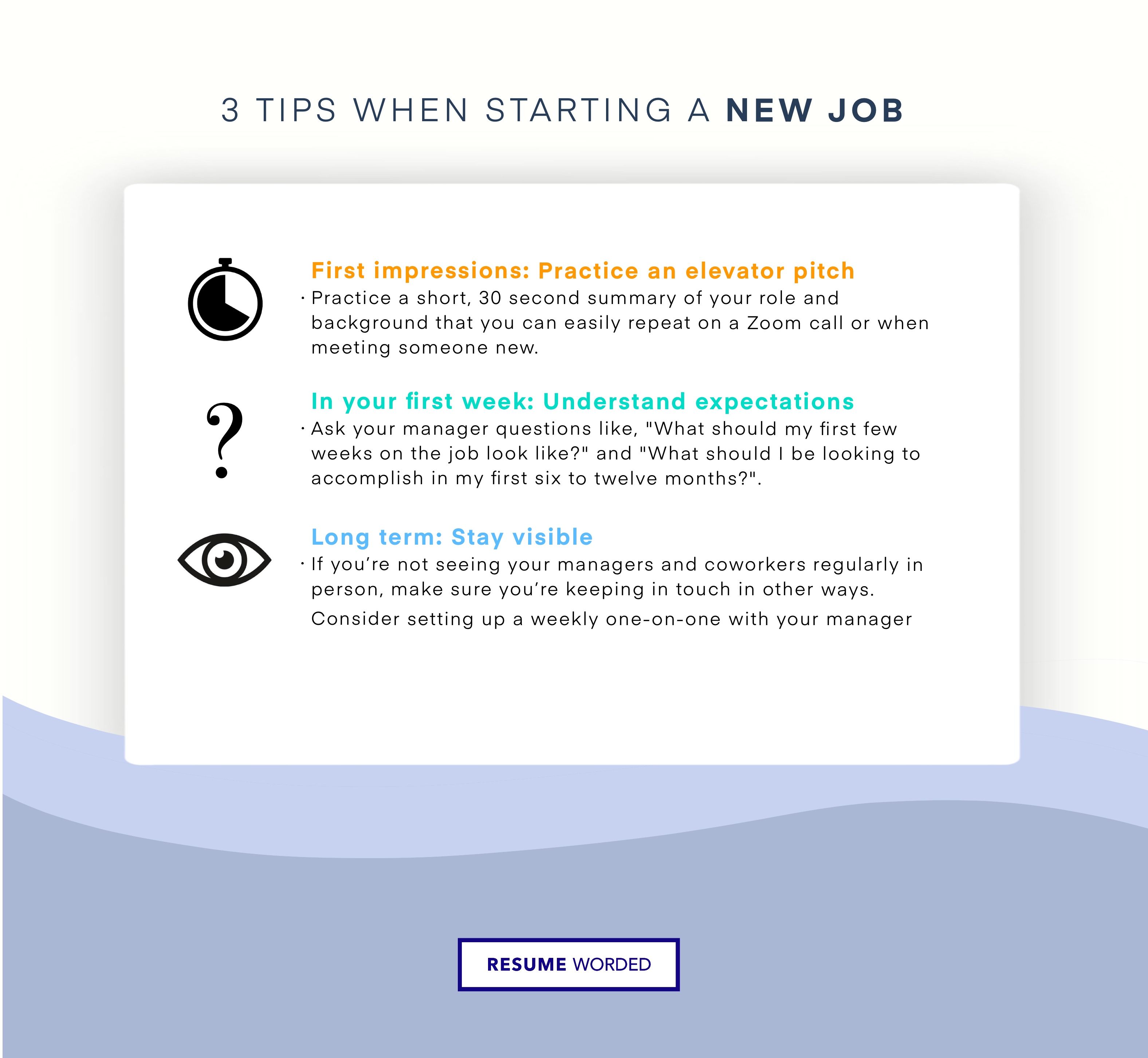Starting a new job is never easy — but I think we can all agree that it’s gotten a little harder in the past two years with everything going remote. Whether it’s how to get to know your coworkers remotely or how to figure out whether your boss prefers phone calls over emails, here are some of our top tips for what to do when starting a new job, from day one first impressions to long-term strategies for success.
Day One: Getting To Know People
Make a first impression … and a second
Making a good first impression in person is relatively simple, and generally only needs to be done once. In a virtual environment, introducing yourself to your coworkers is going to look a lot different.
For example: Don’t expect to be able to introduce yourself once and then forget about it. For your first week or two, be prepared to quickly introduce yourself at the beginning of each new call. This goes double for anyone you aren’t in close daily contact with — remember that your coworkers all have a lot going on right now, and don’t be offended if it takes a few introductions for people to remember who you are.
Arrange your own introductions
Ideally, your boss will arrange for you to (virtually) meet the people on your team, but there’s no harm in taking matters into your own hands. When you start a new job, take a few minutes to send a quick email around to anyone you’re likely to be working with. An introductory email doesn’t have to be long. Try this template:
Hi, I’m [Your Name] and I’m the new [job title]. I look forward to working with you all!
You can also mention one or two important details, like a shared project or a particular assignment you’ve taken over, but it really can be that simple.
Have an elevator pitch
This isn’t just a sales tactic — it’s also a really good way to practice introducing yourself in a limited amount of time. Your elevator pitch should be a short, 30 second summary of your role and background that you can easily repeat on a Zoom call or when meeting someone new. If you’re worried about it being overkill, don’t be — memorizing your intro means you’re less likely to forget what you meant to say, even if you’re put on the spot.
Elevator pitches shouldn't be a boring 'I'm Sally and I work in HR' — aim to make it compelling so people remember who you are. I've compiled a more detailed guide on how to introduce yourself with a killer elevator pitch if that's something you want to work on.
In Your First Week: Getting off on the Right Foot
Understand expectations
Knowing what’s expected of you is crucial in any job, but it’s especially important if you’ll be working remotely. Working in a different physical space from your manager and coworkers means fewer opportunities for you to watch what other people do or gradually correct your mistakes. To hit the ground running, you need to have a clear picture of what your job entails and how you should be doing it.
Set up a meeting with your manager in your first week to explicitly clarify their expectations of the role. Here are some questions you should ask:
- What should my first priority be right now?
- What should my first few weeks on the job look like?
- What should a typical day/week look like once I’ve settled into the role?
- Who do I report directly to?
- How much detail do you want about my day-to-day?
- Who should I ask if I have minor questions or issues?
- What does a high level of productivity look like?
- What should I be looking to accomplish in my first six to twelve months?
- What are your goals/the company’s goals and how does my work factor into that?
Get to know the culture
This is something that’s far easier to do in person, but still possible — and important — if you’re remote. Spend your first few days or weeks carefully observing things like how people in your team communicate and other office norms. Things like: Do people usually spend a few minutes at the start or end of a meeting chatting among themselves or is it straight to business? Do people generally answer emails late at night or over the weekend? Are early morning and late afternoon meetings normal, or are these reserved for a number of core hours?
When it comes to your manager’s preferred communication style, the best strategy may be to come out and ask directly. Some managers prefer a phone call or face-to-face Zoom chat. If email is fine, is it better to send quick questions through as they arise or to save up minor things to send as part of a larger digest? You should also observe how your coworkers communicate — if they need to talk to someone, do they pick up the phone? Send an instant message on Slack? Schedule a quick meeting? — and try to do the same.
Create your own onboarding process
If you’re lucky, your company will have a comprehensive remote onboarding process — but don’t rely on luck. Apart from introducing yourself to your colleagues, there are a few things you can do to make starting your new job a little easier.
Familiarize yourself with the technology. If you’re not already familiar with Zoom, Slack, Teams, or whatever other software your company is using, make this your first priority. If necessary, ask what programs you’ll be using regularly and make sure they’re installed and that you have an account set up.
Understand team processes and workflow. If there are specific processes your team uses, make sure you’re aware of them from the beginning. These may or may not be well documented, so if they aren’t, ask!
Get access to documents you need. You don’t want to have to admit to your manager two weeks into a new position that you haven’t accomplished anything yet because you’re still waiting for access to something you should have had from day one.
In Your First Month: Settling In
Find other new people
If your company is large enough, there may be other recent hires — so get in touch with them. Sharing your experiences with other people who are new to the company can make you feel like you’re less alone and give you some valuable perspective on your experiences.
Expand your social circle
When you’re introducing yourself to people, you don’t need to stick to your immediate team or other new hires. Consider sending an introductory email to people in your wider team, especially if you’re likely to be working with them down the line. You may not be able to go for lunch with your coworkers or share a chat over a morning cup of coffee, but there’s nothing stopping you from suggesting a virtual coffee chat or joining in on social meetings or virtual happy hours.
Prepare for meetings
Good news: Being remote might actually make this one easier. Before any meeting, know who you’ll be talking to, what their position is within the company, and how their role interacts with yours. This could mean searching LinkedIn or your organization’s website. Write down a few notes and relevant questions — if it’s a Zoom meeting, you can even keep these on a sticky note pinned to your monitor so you don’t forget them.
Long Term: Thriving in Your New Role
Stay visible
If you’re not seeing your managers and coworkers regularly in person, make sure you’re keeping in touch in other ways. Consider setting up a weekly one-on-one with your manager, even if there are no major issues to work through.
Also, don’t rely too much on email, where tone and nuance can easily be lost. If you’re unclear on something, suggesting a quick chat instead can be more effective than a long email chain. Try this:
Thanks for sending this over. Can we hop on a brief phone call or video chat and talk about it? I’d like to [ask a few questions/get more context for the assignment/figure out how to get this done most effectively].
Visit Networking Email Templates for more.
Keep track of your accomplishments
“Out of sight, out of mind” might be a cliché, but it’s true. It’s a lot harder to get recognized for your work when it’s happening remotely. Set your own SMART goals and make a note of your achievements, and make sure to mention your accomplishments during regular check-ins or by sending status reports as appropriate.

What Not To Do
Don’t expect everything to be business as usual
While many organizations have been operating remotely for a while now, that doesn’t mean you can expect everything to be running smoothly. Try to get an idea of how current events may be impacting the company and your role.
Don’t put too much pressure on yourself
At the same time, make sure you’re cutting yourself a little slack, too. Starting a new job is never easy, and it’s even harder when you’re remote. Know that it’s okay to take longer than usual to feel like you’ve truly settled in.
Don’t get too comfortable
Even if everyone else on your team starts work at 10 am and shows up to company-wide meetings in their pajamas, that doesn’t mean you should follow their lead. This means using professional judgment — stick to business casual dress, show up to meetings a few minutes early, and make sure you’re available and working during standard business hours, at a bare minimum.
Related: Nervous About a New Job? Here are This Year's Findings on How To Manage New Job Anxiety
Don’t forget to switch off
It can be hard to switch off when you literally live at work, especially when you’re feeling the pressure of a brand new job. Figure out a way to exit “work mode” at the end of the day — whether that’s faking a commute by walking around the block, changing out of your work clothes into something more comfortable, or simply moving from your desk to the couch.










